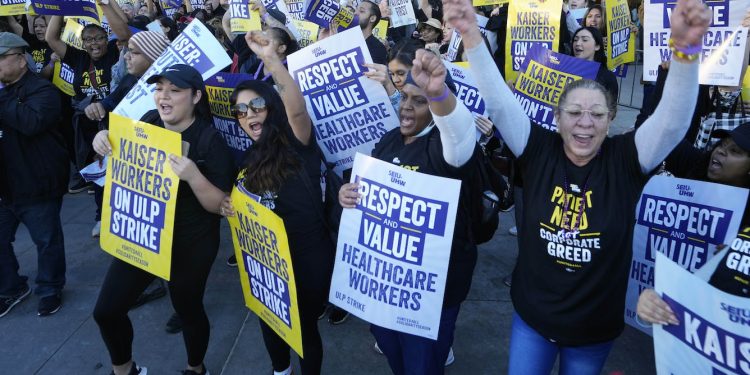Kaiser Permanente well being care staff in 5 states and Washington, D.C., are rallying towards low wages and understaffing that they are saying is undermining affected person care. AP Photo/Damian Dovarganes
More than 75,000 Kaiser Permanente well being care staff started a three-day strike in Virginia, California, Colorado, Washington state, Oregon and Washington, D.C., on Oct. 4, 2023, after firm executives and eight unions representing aides, techs, assist employees and different workers did not agree on the phrases of latest contracts. This is the most important U.S. well being care strike on file. In a press release it launched when the walkout began, Kaiser asserted that it needed to succeed in a deal quickly with the putting staff.
Although hospitals and emergency rooms are nonetheless open in the course of the strike, and Kaiser is making use of short-term staff, lots of its noncritical providers are briefly closed or working beneath lowered hours. The strike doesn’t embody any nurses unions or medical doctors.
The Conversation requested Michael McQuarrie, an Arizona State University sociologist who directs its Center for Work and Democracy, to clarify why this strike is occurring now and the way labor actions like this may have an effect on affected person care.
Kaiser well being care staff on the picket line exterior of a Kaiser Permanente facility in Sacramento, Calif. It is the most important medical care employee strike in U.S. historical past.
1. Why is that this historic strike taking place now?
The two fundamental causes are considerations over staffing ranges and practices and dissatisfaction with pay that hasn’t saved up with inflation and was too low to start with.
Kaiser says its choices are restricted because of a nationwide shortfall in all kinds of well being care staff, together with dwelling well being aides and nurse practitioners. Workers counter that increased pay and higher working circumstances would appeal to extra candidates.
Health care staff have lengthy fearful that insufficient staffing is undercutting the standard of look after sufferers – this has been a central difficulty in contract negotiations and strikes for years. But the COVID-19 pandemic tremendously exacerbated the issue.
At the identical time, inflation has outstripped negotiated wage will increase for Kaiser staff. Kaiser is presently providing some staff in Northern California and Washington state 4% annual raises for the 4 years coated by the brand new contract and decrease raises for everybody else. The unions have rejected this supply, which they are saying wouldn’t make up for previous inflation and would unnecessarily create completely different wage scales primarily based on the area the place staff are situated.
“Why are we right here? Patient care! How can we get it? Higher staffing. Why are we right here? Patient care! How can we get it? Living wages.” Video by Amanda Mascarelli.
2. Has Kaiser’s monetary administration performed a job too?
Kaiser, which supplies well being look after 12.7 million Americans, took in US$95.4 billion in income in 2022 however ran a $1.2 billion working loss that it attributed to “sturdy financial headwinds within the monetary markets” – suggesting that its investments had been responsible moderately than its well being care operations.
For 2021, Kaiser reported that it had about $56 billion in unrestricted money and investments, excluding property tied to worker and retiree pensions.
Kaiser’s earnings within the first half of 2023 totaled about $3.4 billion, nonetheless. And apart from its losses in 2022, Kaiser has been constantly worthwhile for years.
Concerns over low employee pay are rising whereas Kaiser’s government compensation is growing. As of 2021, its CEO Gregory Adams was making greater than $15.5 million a yr in pay and “different” compensation.
3. But isn’t Kaiser a nonprofit – and does that imply it has any particular obligations?
Like many well being care techniques, Kaiser is a nonprofit. This means it pays little or no in taxes. In trade for his or her particular tax standing, nonprofits are supposed to supply public advantages.
Nonprofits might earn more money than they spend, however they will’t distribute earnings to its shareholders. Nonprofit government compensation have to be “cheap,” in line with the Internal Revenue Service – though it may be laborious to find out how a lot is an excessive amount of.
4. Are there any precedents for this strike?
Health care strikes should not uncommon, with greater than 40 occurring up to now two years. However, the business and the workforce are closely fragmented, which signifies that these strikes are usually comparatively small.
In September 2022, the Minnesota Nurses Association took 15,000 members on strike over lots of the similar points, equivalent to staffing and inflation. That strike, which lasted three days, was the most important well being care strike in U.S. historical past by that time in phrases the variety of staff concerned.
Prior to that, the most important was in all probability one other Minnesota strike in 2010, through which about 12,000 nurses walked off the job for twenty-four hours.
Kaiser has skilled a lot smaller strikes up to now, equivalent to a walkout in 2015 of about 75 psychological well being clinicians.
5. How a lot are sufferers harmed throughout well being care strikes?
It is dependent upon the strike, however often not a lot.
Critical care Kaiser amenities will stay open, although the strike will doubtless trigger some delays in care because of brief staffing and lengthy traces.
Some appointments and elective procedures on the affected hospitals are being postponed, and nonessential features like labs and radiology departments are briefly closed or their hours are being lowered.
Nurses, who’re crucial bedside caregivers, are a part of a unique coalition of Kaiser unions. While they gained’t be on strike, they might have to assist cowl work not being finished by aides and different assist employees who’re on the picket traces.
Michael McQuarrie works with and does analysis on unions and different organizations. The Center for Work and Democracy has obtained funding from United Healthcare Workers West/SEIU, which is a part of the Coalition of Kaiser Permanente Unions.











